Sandy Wright's Blog, page 12
July 7, 2018
We Are Aradia
Afternoon fog clung to the sea cliffs as we drove into the headlands of Mendocino State Park.

 For our little band of Arizona witches, this was the culmination of two day’s driving, and the gateway where magic begins.
For our little band of Arizona witches, this was the culmination of two day’s driving, and the gateway where magic begins.
We piled out of the vans with the items we had made, eager to begin our gift exchange. In this way, we showed our fondness for each other, as well as beginning our calming time, our time to settle our minds inward in preparation for the craziness that is Witchcamp check-in.
The gifts are different each year. I’ve received homemade muffins, tote bags, stones, astrology stuff, a pendulum set, an athame, coasters, tarot bags, bath salts.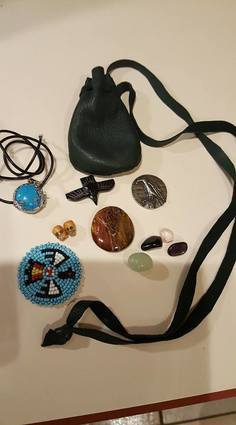 This year, I gave little leather mojo bags with customized totem animals and stones. Every one of the gifts is precious because it’s made with love. When we piled back into the vans for the dirt-road drive into the Redwoods forest campgrounds, my heart was full.
This year, I gave little leather mojo bags with customized totem animals and stones. Every one of the gifts is precious because it’s made with love. When we piled back into the vans for the dirt-road drive into the Redwoods forest campgrounds, my heart was full.
This is my bag. The raven is my totem animal, and my bag is dark green, my favorite color for magic. The two little skulls are for the Ancestors.
Although this is only my second time for the seven-day, intensive magical practice, some people have been attending this camp for nearly two decades. We eat delicious and healthy vegetarian food that is sustainably sourced and prepared by a professional cook staff of witches. They have published their own cookbook. I bought a copy this year and am going to try and coax my meat eating husband to try some of the recipes.
Witchcamp is part gathering, a large part ritual practice, but also so much learning. I got to sit and talk with people from all walks of life, from molecular biologist (he worked on the “clot buster” medicine for stroke victims, of special interest to this stroke survivor), to full-time ecstatic and spiritual workers, to school teachers and nurses, to recovering addicts. All of us were joined in working to make this planet better for our children and their descendants. No electronics to distract us, no outside obligations, just people sharing life experiences together. It was amazing. Eye opening. And humbling. I wished I had more time to become deeply, intimately involved with each of these 150 souls.
This year I camped apart from my AZ group, sharing a cabin with Janeen and Lari, two friends from the Palm Springs area that I met at my first camp. We all decided that the smoking table was its own Affinity group since we got together each night after ritual and between scheduled daytime activities. I don’t recall a single cross word between the three of us. What a blessing it is to have no drama, just companionship and interest in each other.
The week was exhausting, but it recharged my spiritual batteries. I came home with a deeper understanding of who I am. And who I can be.
Now that I’m back in my everyday world I can look back on my favorite events of this year’s camp. When you’re in the midst of the magic, it can be a little overwhelming, so a week of processing and reflection was needed.
Here are some of the moments that made deep impressions:
* The Headlands: Gateway to the Magic. I love you guys!
* Midnight full moon ritual in the ampetheater. “Sparks from the fire of the Queen of Death and Night.”
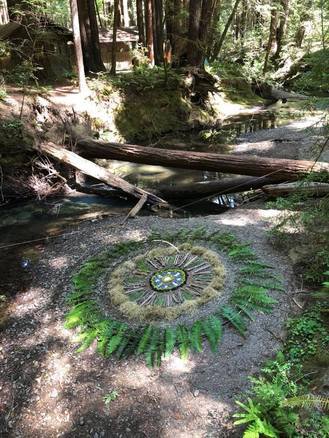 * The beautiful Creekside mandala. Thank you Jeff! * Numerous discussions on white privilege, cultural appropriation, and How Not to be a Racist at Camp. LOTS of processing going on still around this topic. Thank you, path teachers, campers, all of you, for your comments and insights.
* The beautiful Creekside mandala. Thank you Jeff! * Numerous discussions on white privilege, cultural appropriation, and How Not to be a Racist at Camp. LOTS of processing going on still around this topic. Thank you, path teachers, campers, all of you, for your comments and insights.
* Raven’s path discussion on parts of the brain and how they inter-relate. Also the “shen birds” and soul retrieval.
* Thalia, our own firefly. “Deepening in this land, we gather power.”
* 50 witches in red. Red is power!
* So many interesting tattoos! Their origins made fascinating stories around the smoker’s table.
* The constant reminder that Nature is sacred. We are surrounded by it, and it soaks into your pores. Honor the spirits of the place where you are.
* Eye Gazing. “I SEE you.”
* Invocations in Spanish
 * Participating in the Aradia story telling at the camper-run ritual.
* Participating in the Aradia story telling at the camper-run ritual.
Thank you Tarin. I would never have volunteered if you hadn’t given me that opportunity. * Water and ink scrying. Beautiful and so deep. Thank you Scrying in the Dark teachers! * Reading tea leaves. Path this year was fantastic.
* Reading tea leaves. Path this year was fantastic.
* Discovering how much information my tea leaf scrying set gave me. Wow! I’ve had this set for four years and never used it. Now I’ll use it regularly.
* Getting to know my Path teachers Urania and Raven. I love you both. You put so much of yourselves into our group. Heart bumps.
* My fellow “Pathers” and your haunting messages from our exercises:
“A wound creates a voice, and the voice calls in what is needed to heal the wound.”
“Keep salt at the front door,
Twigs at the back.
Pebbles under the bed,
Water on the hearth,
And leave a window cracked.
Keep a flame going.”
*Time spent with Ancestors and Descendants in path and in ritual. Especially the messages I received from the Descendants during our Path meditation. It gives me hope for the future
* Word Witches. Beautiful Affinity Group ritual! Thank you Riyana for suggesting this group, and Star Singer for composing our song.
* “Liberation Song.” It's stuck in my head forever.
* Confirmation that howling at the moon is a perfectly reasonable option in this world gone mad.
* Making the flying ointment. Such a potent night!
* The reminder to work my magic. Always, and especially in the everyday world, where it is desperately needed. I didn’t spend all this time learning magic to impress my friends. I learned it for times like this. Go use it! Do what must be done.
Aradia. Thank you, my 2nd Degree patroness, for urging me to go to Witchcamp and GO DEEP with you. Finally, right? Now…what do you have planned next? I can’t wait to find out!
Blessed Be all.

 For our little band of Arizona witches, this was the culmination of two day’s driving, and the gateway where magic begins.
For our little band of Arizona witches, this was the culmination of two day’s driving, and the gateway where magic begins.We piled out of the vans with the items we had made, eager to begin our gift exchange. In this way, we showed our fondness for each other, as well as beginning our calming time, our time to settle our minds inward in preparation for the craziness that is Witchcamp check-in.
The gifts are different each year. I’ve received homemade muffins, tote bags, stones, astrology stuff, a pendulum set, an athame, coasters, tarot bags, bath salts.
 This year, I gave little leather mojo bags with customized totem animals and stones. Every one of the gifts is precious because it’s made with love. When we piled back into the vans for the dirt-road drive into the Redwoods forest campgrounds, my heart was full.
This year, I gave little leather mojo bags with customized totem animals and stones. Every one of the gifts is precious because it’s made with love. When we piled back into the vans for the dirt-road drive into the Redwoods forest campgrounds, my heart was full. This is my bag. The raven is my totem animal, and my bag is dark green, my favorite color for magic. The two little skulls are for the Ancestors.
Although this is only my second time for the seven-day, intensive magical practice, some people have been attending this camp for nearly two decades. We eat delicious and healthy vegetarian food that is sustainably sourced and prepared by a professional cook staff of witches. They have published their own cookbook. I bought a copy this year and am going to try and coax my meat eating husband to try some of the recipes.
Witchcamp is part gathering, a large part ritual practice, but also so much learning. I got to sit and talk with people from all walks of life, from molecular biologist (he worked on the “clot buster” medicine for stroke victims, of special interest to this stroke survivor), to full-time ecstatic and spiritual workers, to school teachers and nurses, to recovering addicts. All of us were joined in working to make this planet better for our children and their descendants. No electronics to distract us, no outside obligations, just people sharing life experiences together. It was amazing. Eye opening. And humbling. I wished I had more time to become deeply, intimately involved with each of these 150 souls.
This year I camped apart from my AZ group, sharing a cabin with Janeen and Lari, two friends from the Palm Springs area that I met at my first camp. We all decided that the smoking table was its own Affinity group since we got together each night after ritual and between scheduled daytime activities. I don’t recall a single cross word between the three of us. What a blessing it is to have no drama, just companionship and interest in each other.
The week was exhausting, but it recharged my spiritual batteries. I came home with a deeper understanding of who I am. And who I can be.
Now that I’m back in my everyday world I can look back on my favorite events of this year’s camp. When you’re in the midst of the magic, it can be a little overwhelming, so a week of processing and reflection was needed.
Here are some of the moments that made deep impressions:
* The Headlands: Gateway to the Magic. I love you guys!
* Midnight full moon ritual in the ampetheater. “Sparks from the fire of the Queen of Death and Night.”
 * The beautiful Creekside mandala. Thank you Jeff! * Numerous discussions on white privilege, cultural appropriation, and How Not to be a Racist at Camp. LOTS of processing going on still around this topic. Thank you, path teachers, campers, all of you, for your comments and insights.
* The beautiful Creekside mandala. Thank you Jeff! * Numerous discussions on white privilege, cultural appropriation, and How Not to be a Racist at Camp. LOTS of processing going on still around this topic. Thank you, path teachers, campers, all of you, for your comments and insights.* Raven’s path discussion on parts of the brain and how they inter-relate. Also the “shen birds” and soul retrieval.
* Thalia, our own firefly. “Deepening in this land, we gather power.”
* 50 witches in red. Red is power!
* So many interesting tattoos! Their origins made fascinating stories around the smoker’s table.
* The constant reminder that Nature is sacred. We are surrounded by it, and it soaks into your pores. Honor the spirits of the place where you are.
* Eye Gazing. “I SEE you.”
* Invocations in Spanish
 * Participating in the Aradia story telling at the camper-run ritual.
* Participating in the Aradia story telling at the camper-run ritual.
Thank you Tarin. I would never have volunteered if you hadn’t given me that opportunity. * Water and ink scrying. Beautiful and so deep. Thank you Scrying in the Dark teachers!
 * Reading tea leaves. Path this year was fantastic.
* Reading tea leaves. Path this year was fantastic.* Discovering how much information my tea leaf scrying set gave me. Wow! I’ve had this set for four years and never used it. Now I’ll use it regularly.
* Getting to know my Path teachers Urania and Raven. I love you both. You put so much of yourselves into our group. Heart bumps.
* My fellow “Pathers” and your haunting messages from our exercises:
“A wound creates a voice, and the voice calls in what is needed to heal the wound.”
“Keep salt at the front door,
Twigs at the back.
Pebbles under the bed,
Water on the hearth,
And leave a window cracked.
Keep a flame going.”
*Time spent with Ancestors and Descendants in path and in ritual. Especially the messages I received from the Descendants during our Path meditation. It gives me hope for the future
* Word Witches. Beautiful Affinity Group ritual! Thank you Riyana for suggesting this group, and Star Singer for composing our song.
* “Liberation Song.” It's stuck in my head forever.
* Confirmation that howling at the moon is a perfectly reasonable option in this world gone mad.
* Making the flying ointment. Such a potent night!
* The reminder to work my magic. Always, and especially in the everyday world, where it is desperately needed. I didn’t spend all this time learning magic to impress my friends. I learned it for times like this. Go use it! Do what must be done.
Aradia. Thank you, my 2nd Degree patroness, for urging me to go to Witchcamp and GO DEEP with you. Finally, right? Now…what do you have planned next? I can’t wait to find out!
Blessed Be all.
Published on July 07, 2018 19:08
June 17, 2018
Next Up: Witch Camp
 Every few years, I caravan with a dozen witchy friends to the Mendocino Redwoods State Park to attend the California Witch camp.
Every few years, I caravan with a dozen witchy friends to the Mendocino Redwoods State Park to attend the California Witch camp.Maybe you didn’t know there is such a thing as a camp for witches? In fact, there are a couple dozen Reclaiming Witch camps scattered around the United States, Canada. Europe and Australia. In the US, there are camps in Texas, Pennsylvania, Minnesota, Maine and Vermont, as well as the one I’m attending, and a teen camp in California.
The camp is seven days of intensive ritual and magic. It’s definitely not a festival, although there is a lot of singing and drumming and bonfires. Instead, these seven days are likely to expand your consciousness (while being drug-free), push your edges, and oftentimes change your view of life.
 We camp in rustic cabins surrounded by redwood forest. It gets cold, into the forties sometimes, and the cabins have only screens in the top half (to keep the mosquitoes from eating you alive. But they still do.) Because I bring flannel sheets, a sleeping bag and a down comforter, I sleep like a baby.
We camp in rustic cabins surrounded by redwood forest. It gets cold, into the forties sometimes, and the cabins have only screens in the top half (to keep the mosquitoes from eating you alive. But they still do.) Because I bring flannel sheets, a sleeping bag and a down comforter, I sleep like a baby.There are no electronics, including cell phones (and no reception even if you tried to cheat), and everyone is asked to commit to the full seven days, since each day builds on what we have learned and experienced previously.
My little Arizona contingent van-pools from Phoenix to Mendocino over two days. When we arrive, we find our cabins and haul all of our gear into camp in wagons. This year, instead of camping with the crew I’m traveling with, I’m bunking with two friends I met at the last camp. I have no idea where our cabin will be, but I’ll post pictures after we get it “glammed” up.
 We also sign up for our work detail assignments while checking in. The camp doesn’t run itself, so everyone signs up for 3 chores. I’ve done everything from gathering and sorting firewood (pic), to cleaning the one large community shower. This year, I think I’ll wash lunch or dinner dishes. I know myself well enough to skip the breakfast help crew, since they report to work before 6:00 am. I did tell you I sleep soundly at camp, right?
We also sign up for our work detail assignments while checking in. The camp doesn’t run itself, so everyone signs up for 3 chores. I’ve done everything from gathering and sorting firewood (pic), to cleaning the one large community shower. This year, I think I’ll wash lunch or dinner dishes. I know myself well enough to skip the breakfast help crew, since they report to work before 6:00 am. I did tell you I sleep soundly at camp, right? 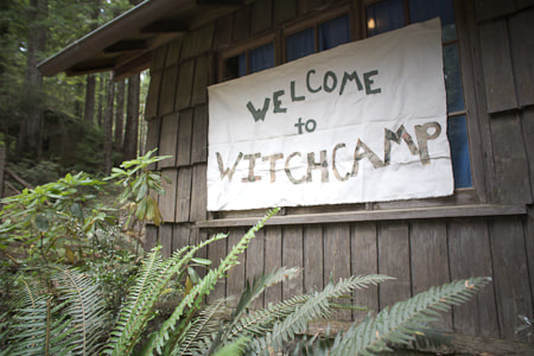 On the first night, the teachers introduce themselves and explain the path (class) they’re teaching for the week. Then we campers get to choose our focus of study for the week.
On the first night, the teachers introduce themselves and explain the path (class) they’re teaching for the week. Then we campers get to choose our focus of study for the week. Two years ago, my first time for Witch camp, I took the required newbie Elements class, and it was enjoyable. This year I’m leaning toward a class titled, “The Oracle of the Witches: Scrying in the Dark.” Doesn’t that sound delicious?
The overall theme for the camp varies annually. This year is, “Aradia, Queen of the Witches.” I specifically chose to attend this year because Aradia is one of my two patron goddesses. She is a stern teacher, so the week should be interesting.
Afternoons are for “affinity” groups, a place to share and get emotional support. A lot of heavy emotions, revelations and healing needs bubble to the surface during Witch camp, so it’s nice to have a small group of support campers you can share with and feel safe.
At night, the whole camp (usually around 100 campers) comes together for evening rituals around a huge bonfire (the camp has certified fire tenders to meet the Forest Service standards).
One evening is saved for an often hilarious, and always entertaining, talent show and fund-raiser auction. And then there is Chocolate Night, filled with sweets, massage, Reiki, and much more.
The best part: We don’t have to cook! There is a camp cooking staff, all vegetarian, and all amazingly delicious! They’ve even published a cookbook.
So, if you practice magic and would like to take your skills to the next level with a like-minded group, consider the Reclaiming Witchcamp of your choice. I highly recommend the experience, more than once, in fact.
Published on June 17, 2018 19:00
June 7, 2018
Purple is for Antagonist
 I’m heavy into book planning this week, rather than writing new words. This is a result of what I learned at Cherry Adair’s PLOTTING BY COLOR workshop.
I’m heavy into book planning this week, rather than writing new words. This is a result of what I learned at Cherry Adair’s PLOTTING BY COLOR workshop.While the pressure to have this book finished by year-end is heavy on my shoulders, it’s actually a relief to stop plowing forward, and instead to pause and dig even deeper into my characters motivations and reactions dictated by their backstory and previous lives.
This digging has given me a different perspective in my bad guys, especially unfaithful husband Jace, and the killer, who will remain unnamed. In fact, I’ve developed a new subplot layer, and now have the two men’s pasts intertwined in more than the shared Army experience.
This subplot will require some major rewriting in my first 50,000 words, but it makes the killer’s behavior more understandable, but no less chilling.
One of the things that Cherry stressed, over and over, in her workshop: Start your planning with your antagonist. This was a revelation to me. I’ve always worked my stories around the two protagonists—their obstacles and the struggles to overcome them. But now it makes perfect sense. After all, it’s the bad guys, the antagonists, who are throwing those obstacles in the path of my good guys in the first place.
So I’m now creating an actual, physical plot board to track my book by chapters. And the first colored post-it notes to go on that board are PURPLE. Because, as Cherry says, Purple is for Antagonist.
Have you used a similar system to plot out your novel? If so, I’d love to hear how it’s working for you.
Hopefully you used the system at the outset of a book, instead of when you’re 50k into writing. But hey, better late than never. I think my readers will appreciate the effort.
P.S. Never fear, I will have these changes done by next week, and be back to writing new words again!
Published on June 07, 2018 15:31
May 31, 2018
Keeping your Midlife Mojo
Mojo
(definition)
1. An amulet, charm, or magic spell
2. The art of casting magic spells
3. Uncanny personal power or influence
 We all know someone who, despite being older, still has it. Not the desperate, trying to cling to a lost youth persona, but genuinely attractive, super interesting charisma, the whole package type of magic.
We all know someone who, despite being older, still has it. Not the desperate, trying to cling to a lost youth persona, but genuinely attractive, super interesting charisma, the whole package type of magic.
Mojo. The people who have it exude chemistry, intrigue, and a sense of adventure. No matter their age, they still turn heads--and say ‘thank you’ for the attention. They seem timeless, or at least relatively unscathed by the passing years, and, in some cases, even seem to get better with age. The relaxed confidence that comes from knowing yourself can be a very powerful aphrodisiac.
 Do you feel like your mojo is dead, gone, that it has packed its bags, checked out of your condo, and headed alone to Bermuda? Well, think again.
Do you feel like your mojo is dead, gone, that it has packed its bags, checked out of your condo, and headed alone to Bermuda? Well, think again.
Your mojo is still here, waiting for you to pay it some sweet attention. Seriously. Your dynamic, inspired, hot to trot self is hiding away, sleeping. Do you want to reactivate it? Sure, you say. But how? Here are some ideas:
Get a fun hobby
Having fun is intoxicating. Laughing brightens your face and causes feel-good chemicals to rush around inside. The glow of enthusiasm, the twinkle in your eyes, the unity that happens when you have something in common with others, is gooey like caramel. It helps you stick together with others, and it is easy to enjoy. Being around others while you are doing something you are passionate about feels awesome. And, it is very sexy. Sexy is fun. Get a fun hobby.
Start with one small win.
If you let yourself think you'll never be able to win again, you're setting yourself up for the very failure you fear. It's easy to feel overwhelmed when you're trying to reverse your mindset, so try focusing on doing small things well. You don't have to take on the world--just complete one small task with focus and excellence. That small win can help restore your confidence. And if you repeat it, again and again, one step at a time, suddenly you will have managed what may have felt unmanageable.
Shift your Perspective. Sometimes you may feel like you're stuck in cement. Nothing you try seems to work. Stop! Have you been trying new things, or just variations on the same things that you already know don't work? To shift your perspective and regain your mojo, try doing old things in new ways. And that means changing the way you look at things. Changing your view and your perspective can help you find new solutions and new confidence.
Talk Positive.
Sometimes we can be our own worst enemy. Especially when you're down, you may judge yourself harshly and speak internally to yourself in terrible ways that you'd never use with anyone else. You can reverse abusive self-talk with the SOS technique:
Stop and take a breath--this gives you an opportunity to interrupt the cycle.Observe what you're saying to yourself and how it makes you feel.Shift your response.
Do something that goes against your character
Maybe it’s staying in bed all day with a good book, sumptuously scented tea, and a cat. Maybe it’s flirting with a good looking stranger while you’re out with friends. Maybe it’s jumping off a mountain or doing stand-up comedy. Do something that gets you focused on pleasure, on abandon, and about relishing your life.
Give yourself a standing O
You are phenomenal. You are interesting. You are magnificent. You are amazing. You are beautiful. You are so smart. You are important.
Does all this complimenting embarrass you? If so, it is time to give yourself a standing O…a standing ovation, that is.
The shift in your mojo, once you decide you are truly worthwhile, is huge. You are like no other person on this earth, which makes you priceless. But do you realize it? Do you admit your value and contribution? Do you celebrate your wins? You should, because you deserve it.
Getting comfortable with idea that you matter is essential. Take the time to give yourself a standing O.
Only listen to the people who count--then listen to them carefully
You don’t have the time or the energy to listen to opinions of idiots. That’s one joy of getting older—the number of people whose opinions really, really matter has dwindled to maybe 10. These are the people who know you the best, love you the most. They are the ones who will also tell the truth, and knock you on the side of the head when you’re out of line. You’ve learned through the years of experience who they are. Cherish them and listen to their words carefully.
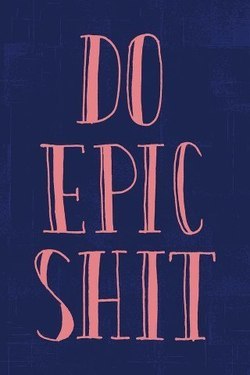 Live Meaningfully
Live Meaningfully
The trouble with the career advice we receive as young people is that it revolves around the question ‘What do you want to do when you grow up?’
A more authentic decision might be about what kind of person you hope to be. Many people, once they have a solid amount of life experiences, learn (the hard way or not) that the most important thing in your life is who you are, not what you do.
The answer, I believe, is like so many of the most important truths in life. It’s a matter of contemplating potentially conflicting ideas in your mind at the same time: knowing, doing and being. And then, resolving those conflicts keeping your main focus—what will your best self do?—uppermost in your mind.
If you’re living meaningfully, you will remain vital and inspired, no matter your age. You won’t look back with regret, or fear death in the future, because, quite simply, you are living as your best self. So get off your ass and do something. Improve the environment, improve something somewhere in the world. Help the people you love the most. And help yourself to be the person you wanted to be when you received that career advice at graduation.
And if you lose track of the meaning…
Re-Focus on your Mission, not your obligations. If you get caught up in a cycle of obligations but shut off from your own positive forces, you can lose touch with what drives you, and you may find yourself trudging through the day. If that happens, it's time to stop and focus on your mission. Why are you doing what you do? What's the motivation, the drive, the passion, behind everything you're doing? If you can find your mission, you'll get back your motivation, and if you get back your motivation you will find your confidence.
You have mojo. Reactivating it will enliven your creative life. Try the above suggestions for a week and see what happens. You will be amazed at what small incremental changes can have on how you feel.
Now go and be awesome!
(definition)
1. An amulet, charm, or magic spell
2. The art of casting magic spells
3. Uncanny personal power or influence
 We all know someone who, despite being older, still has it. Not the desperate, trying to cling to a lost youth persona, but genuinely attractive, super interesting charisma, the whole package type of magic.
We all know someone who, despite being older, still has it. Not the desperate, trying to cling to a lost youth persona, but genuinely attractive, super interesting charisma, the whole package type of magic.Mojo. The people who have it exude chemistry, intrigue, and a sense of adventure. No matter their age, they still turn heads--and say ‘thank you’ for the attention. They seem timeless, or at least relatively unscathed by the passing years, and, in some cases, even seem to get better with age. The relaxed confidence that comes from knowing yourself can be a very powerful aphrodisiac.
 Do you feel like your mojo is dead, gone, that it has packed its bags, checked out of your condo, and headed alone to Bermuda? Well, think again.
Do you feel like your mojo is dead, gone, that it has packed its bags, checked out of your condo, and headed alone to Bermuda? Well, think again. Your mojo is still here, waiting for you to pay it some sweet attention. Seriously. Your dynamic, inspired, hot to trot self is hiding away, sleeping. Do you want to reactivate it? Sure, you say. But how? Here are some ideas:
Get a fun hobby
Having fun is intoxicating. Laughing brightens your face and causes feel-good chemicals to rush around inside. The glow of enthusiasm, the twinkle in your eyes, the unity that happens when you have something in common with others, is gooey like caramel. It helps you stick together with others, and it is easy to enjoy. Being around others while you are doing something you are passionate about feels awesome. And, it is very sexy. Sexy is fun. Get a fun hobby.
Start with one small win.
If you let yourself think you'll never be able to win again, you're setting yourself up for the very failure you fear. It's easy to feel overwhelmed when you're trying to reverse your mindset, so try focusing on doing small things well. You don't have to take on the world--just complete one small task with focus and excellence. That small win can help restore your confidence. And if you repeat it, again and again, one step at a time, suddenly you will have managed what may have felt unmanageable.
Shift your Perspective. Sometimes you may feel like you're stuck in cement. Nothing you try seems to work. Stop! Have you been trying new things, or just variations on the same things that you already know don't work? To shift your perspective and regain your mojo, try doing old things in new ways. And that means changing the way you look at things. Changing your view and your perspective can help you find new solutions and new confidence.
Talk Positive.
Sometimes we can be our own worst enemy. Especially when you're down, you may judge yourself harshly and speak internally to yourself in terrible ways that you'd never use with anyone else. You can reverse abusive self-talk with the SOS technique:
Stop and take a breath--this gives you an opportunity to interrupt the cycle.Observe what you're saying to yourself and how it makes you feel.Shift your response.
Do something that goes against your character
Maybe it’s staying in bed all day with a good book, sumptuously scented tea, and a cat. Maybe it’s flirting with a good looking stranger while you’re out with friends. Maybe it’s jumping off a mountain or doing stand-up comedy. Do something that gets you focused on pleasure, on abandon, and about relishing your life.
Give yourself a standing O
You are phenomenal. You are interesting. You are magnificent. You are amazing. You are beautiful. You are so smart. You are important.
Does all this complimenting embarrass you? If so, it is time to give yourself a standing O…a standing ovation, that is.
The shift in your mojo, once you decide you are truly worthwhile, is huge. You are like no other person on this earth, which makes you priceless. But do you realize it? Do you admit your value and contribution? Do you celebrate your wins? You should, because you deserve it.
Getting comfortable with idea that you matter is essential. Take the time to give yourself a standing O.
Only listen to the people who count--then listen to them carefully
You don’t have the time or the energy to listen to opinions of idiots. That’s one joy of getting older—the number of people whose opinions really, really matter has dwindled to maybe 10. These are the people who know you the best, love you the most. They are the ones who will also tell the truth, and knock you on the side of the head when you’re out of line. You’ve learned through the years of experience who they are. Cherish them and listen to their words carefully.
 Live Meaningfully
Live MeaningfullyThe trouble with the career advice we receive as young people is that it revolves around the question ‘What do you want to do when you grow up?’
A more authentic decision might be about what kind of person you hope to be. Many people, once they have a solid amount of life experiences, learn (the hard way or not) that the most important thing in your life is who you are, not what you do.
The answer, I believe, is like so many of the most important truths in life. It’s a matter of contemplating potentially conflicting ideas in your mind at the same time: knowing, doing and being. And then, resolving those conflicts keeping your main focus—what will your best self do?—uppermost in your mind.
If you’re living meaningfully, you will remain vital and inspired, no matter your age. You won’t look back with regret, or fear death in the future, because, quite simply, you are living as your best self. So get off your ass and do something. Improve the environment, improve something somewhere in the world. Help the people you love the most. And help yourself to be the person you wanted to be when you received that career advice at graduation.
And if you lose track of the meaning…
Re-Focus on your Mission, not your obligations. If you get caught up in a cycle of obligations but shut off from your own positive forces, you can lose touch with what drives you, and you may find yourself trudging through the day. If that happens, it's time to stop and focus on your mission. Why are you doing what you do? What's the motivation, the drive, the passion, behind everything you're doing? If you can find your mission, you'll get back your motivation, and if you get back your motivation you will find your confidence.
You have mojo. Reactivating it will enliven your creative life. Try the above suggestions for a week and see what happens. You will be amazed at what small incremental changes can have on how you feel.
Now go and be awesome!
Published on May 31, 2018 20:14
May 19, 2018
see you next week
 It's getting hot in Phoenix (above 100 degrees), which always gives me the itch to visit our mountain cabin.
It's getting hot in Phoenix (above 100 degrees), which always gives me the itch to visit our mountain cabin. Paul has already put in his garden there. Sigh. At least I still have killer tomatoes here, despite the heat.
I haven't seen Woody or Teak or Sadie (not pictured) for two weeks, and I can't wait to start up our daily walks in the forest.
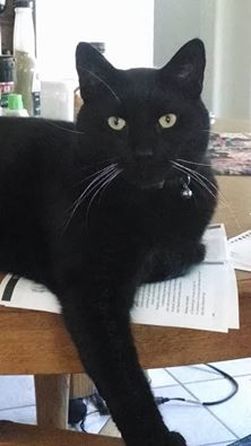 I miss this guy, Shadow Moon, and his brother Salem also. So much.
I miss this guy, Shadow Moon, and his brother Salem also. So much.No doubt, as soon as I spread out my manuscript papers, Shadow will be on top of them "helping" me.
While I'm stuck in Phoenix feeling nostalgic... Good reading and writing!
See you next Friday.
Published on May 19, 2018 18:32
May 12, 2018
Cherry Adair Workshop
So excited! I’m off to Reno again, this time to participate in a writer’s workshop led by romantic suspense author Cherry Adair.  I haven’t met Cherry personally yet, but I’m already a fan of her Cutter Kay and Lodestone series. Plus, for the last year I’ve participated in her Finish the Damn Book contest. You commit to finishing your book in a year. She picks a winner from a random drawing of finishers, then introduces him or her to her editor and publisher.
I haven’t met Cherry personally yet, but I’m already a fan of her Cutter Kay and Lodestone series. Plus, for the last year I’ve participated in her Finish the Damn Book contest. You commit to finishing your book in a year. She picks a winner from a random drawing of finishers, then introduces him or her to her editor and publisher.
Throughout the year, she gives us pep talks, organizes writing sprints with us, and even volunteers periodically to read and critique pages from your work in progress. The support this woman gives to the writing community is amazing!
This year, I budgeted to finally attend Cherry’s Master Writing Class, held in conjunction with the Romantic Times conference, and meet her in person.
 One of her past attendees says, “If you want to learn how to plot, and plot FAST you need to spend time with Cherry. Take her master class. It’s the best thing you can do to jump start your actual writing process.”
One of her past attendees says, “If you want to learn how to plot, and plot FAST you need to spend time with Cherry. Take her master class. It’s the best thing you can do to jump start your actual writing process.”
I’ve been writing for year, and I’ve taken way too many writing courses. But Cherry’s system is touted as a no B.S., sit-down-and-do it, finish the damn book. It sounds like exactly what I need. She has a patented method to plot your entire book, using a large display board and colored post-it notes.
I’m looking forward to tackling Book Two in my Ancient Magic series, surrounded by other writers willing to help fill in everyone’s plot holes, as we all listen to Cherry’s unedited tips/tricks/strategies.
She said to bring everything I have about the book I want to plot, those scraps of paper with story and character ideas. I’ll come home with a “fabulous, intricately plotted book. Whoopie!
“I loathe writing first drafts,” she says. “To me it’s like wading through wet cement, and it takes me forever because there’s always something I’d rather be doing. Which is why I stopped writing by the seat of my pants very early in my career and came up with my plotting by color method. Now the map of my story is easy to follow and relatively painless. Once that first draft is done, it’s another story. I can’t be torn away from my computer. I go back and layer and texture, polish, tweak, and fluff!
She’s now the author of forty-plus books, so I want to do what she’d doing!
I’m already a plotter, but I can’t wait to learn how to do it faster, and with a plan and structure that will work book after book. Yes, I already know to include an opening hook, a Black Moment, scene goals. But I’ve heard her “9 P’s of Plotting” handout is an eye-opener that will have you planning your book actions with more authority.
 Like another favorite teacher of mine, Margie Lawson, Cherry writes everything in color. Backstory is blue, so it’s easy to parcel it into the book in tiny increments. She says that dialogue interweaved with narrative is good, as narrative backstory slows the story down. But—this hadn’t occurred to me—you can do these sections all in narrative to begin with, and then rework most of it into dialog during revisions. Eureka!
Like another favorite teacher of mine, Margie Lawson, Cherry writes everything in color. Backstory is blue, so it’s easy to parcel it into the book in tiny increments. She says that dialogue interweaved with narrative is good, as narrative backstory slows the story down. But—this hadn’t occurred to me—you can do these sections all in narrative to begin with, and then rework most of it into dialog during revisions. Eureka!
She says while you’re writing you should always have open a “snips folder,” Master document and/or Story Bible, and your manuscript. I don’t know exactly what those are, but I’m looking forward to finding out.
She also says you don’t strictly have to write only what you know personally. She likes writing about Venezuela, Egypt and diving, for example, even though she has no desire to learn to dive. And she’s been known to have her students build their characters from Linda Goodman’s Sun Signs. Hey, I’m game. Think I’ll take a deck of Tarot cards for character traits also.
We visited Scotland last year so I could research this next book first-hand, but I feel like there is so much to learn about the Paleolithic sites there that I’m going to get bogged down for months trying to research it all.
For Cherry, research is green. I’m hoping her workshop will help me drill down to the most important places and people, and then be able to slap on those green sticky notes without guilt.
Cherry also talks about good characters, bad ones, and gives special emphasis to the “grey” ones. I have a lot of grey characters, including my male protagonist, Nicholas Orenda. Even without hearing what she has to say, it’s nice to know she acknowledges those people who live on the edge of good and evil (think Severus Snape). I’ve gotten dinged in a few reviews on the first book, Song of the Ancients, because those readers couldn’t understand why Samantha would fall in love with a man like Nicholas. In my humble opinion, ladies, we fall for the Nicholas’s of the world a LOT. And, just like in the series, we often suffer the consequences. But that’s life—it’s not black and white. It’s primarily shades of grey, and the trick is to figure out where we’re going to shove our moral stake in the ground and stand firm.
She also suggests watching movies to see where the beats are, preferably movies you know well. Watch the clock to spot the beats and you’ll be able to translate that timing into your own writing.
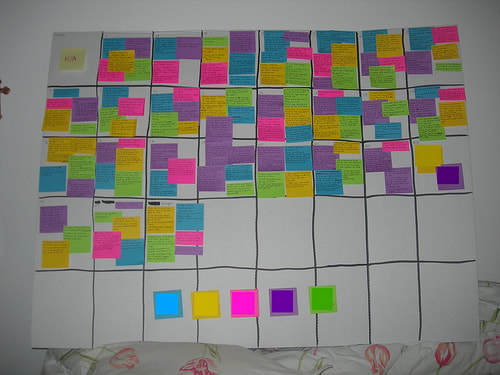 “I love, love teaching everything I‘ve learned about writing over the years to other authors,” Cherry says. “It gives me such a kick to see the OMG! look in someone’s eyes a second before their head goes down, their fingers fly as they write or type at lightning speed. I know that whatever I just said resonated, and she’s no longer even in the same room, but off applying it to her own story oblivious to everyone around her. I know what that feels like, and I want the students/writers in my classes to have that ah-ha moment every time I teach the craft of writing.”
“I love, love teaching everything I‘ve learned about writing over the years to other authors,” Cherry says. “It gives me such a kick to see the OMG! look in someone’s eyes a second before their head goes down, their fingers fly as they write or type at lightning speed. I know that whatever I just said resonated, and she’s no longer even in the same room, but off applying it to her own story oblivious to everyone around her. I know what that feels like, and I want the students/writers in my classes to have that ah-ha moment every time I teach the craft of writing.”
Now, you’ll have to excuse me—I need to get to Reno to play in my stack of brightly colored sticky notes—and hopefully come back with the full outline of a new book!
 I haven’t met Cherry personally yet, but I’m already a fan of her Cutter Kay and Lodestone series. Plus, for the last year I’ve participated in her Finish the Damn Book contest. You commit to finishing your book in a year. She picks a winner from a random drawing of finishers, then introduces him or her to her editor and publisher.
I haven’t met Cherry personally yet, but I’m already a fan of her Cutter Kay and Lodestone series. Plus, for the last year I’ve participated in her Finish the Damn Book contest. You commit to finishing your book in a year. She picks a winner from a random drawing of finishers, then introduces him or her to her editor and publisher. Throughout the year, she gives us pep talks, organizes writing sprints with us, and even volunteers periodically to read and critique pages from your work in progress. The support this woman gives to the writing community is amazing!
This year, I budgeted to finally attend Cherry’s Master Writing Class, held in conjunction with the Romantic Times conference, and meet her in person.
 One of her past attendees says, “If you want to learn how to plot, and plot FAST you need to spend time with Cherry. Take her master class. It’s the best thing you can do to jump start your actual writing process.”
One of her past attendees says, “If you want to learn how to plot, and plot FAST you need to spend time with Cherry. Take her master class. It’s the best thing you can do to jump start your actual writing process.”I’ve been writing for year, and I’ve taken way too many writing courses. But Cherry’s system is touted as a no B.S., sit-down-and-do it, finish the damn book. It sounds like exactly what I need. She has a patented method to plot your entire book, using a large display board and colored post-it notes.
I’m looking forward to tackling Book Two in my Ancient Magic series, surrounded by other writers willing to help fill in everyone’s plot holes, as we all listen to Cherry’s unedited tips/tricks/strategies.
She said to bring everything I have about the book I want to plot, those scraps of paper with story and character ideas. I’ll come home with a “fabulous, intricately plotted book. Whoopie!
“I loathe writing first drafts,” she says. “To me it’s like wading through wet cement, and it takes me forever because there’s always something I’d rather be doing. Which is why I stopped writing by the seat of my pants very early in my career and came up with my plotting by color method. Now the map of my story is easy to follow and relatively painless. Once that first draft is done, it’s another story. I can’t be torn away from my computer. I go back and layer and texture, polish, tweak, and fluff!
She’s now the author of forty-plus books, so I want to do what she’d doing!
I’m already a plotter, but I can’t wait to learn how to do it faster, and with a plan and structure that will work book after book. Yes, I already know to include an opening hook, a Black Moment, scene goals. But I’ve heard her “9 P’s of Plotting” handout is an eye-opener that will have you planning your book actions with more authority.
 Like another favorite teacher of mine, Margie Lawson, Cherry writes everything in color. Backstory is blue, so it’s easy to parcel it into the book in tiny increments. She says that dialogue interweaved with narrative is good, as narrative backstory slows the story down. But—this hadn’t occurred to me—you can do these sections all in narrative to begin with, and then rework most of it into dialog during revisions. Eureka!
Like another favorite teacher of mine, Margie Lawson, Cherry writes everything in color. Backstory is blue, so it’s easy to parcel it into the book in tiny increments. She says that dialogue interweaved with narrative is good, as narrative backstory slows the story down. But—this hadn’t occurred to me—you can do these sections all in narrative to begin with, and then rework most of it into dialog during revisions. Eureka!She says while you’re writing you should always have open a “snips folder,” Master document and/or Story Bible, and your manuscript. I don’t know exactly what those are, but I’m looking forward to finding out.
She also says you don’t strictly have to write only what you know personally. She likes writing about Venezuela, Egypt and diving, for example, even though she has no desire to learn to dive. And she’s been known to have her students build their characters from Linda Goodman’s Sun Signs. Hey, I’m game. Think I’ll take a deck of Tarot cards for character traits also.
We visited Scotland last year so I could research this next book first-hand, but I feel like there is so much to learn about the Paleolithic sites there that I’m going to get bogged down for months trying to research it all.
For Cherry, research is green. I’m hoping her workshop will help me drill down to the most important places and people, and then be able to slap on those green sticky notes without guilt.
Cherry also talks about good characters, bad ones, and gives special emphasis to the “grey” ones. I have a lot of grey characters, including my male protagonist, Nicholas Orenda. Even without hearing what she has to say, it’s nice to know she acknowledges those people who live on the edge of good and evil (think Severus Snape). I’ve gotten dinged in a few reviews on the first book, Song of the Ancients, because those readers couldn’t understand why Samantha would fall in love with a man like Nicholas. In my humble opinion, ladies, we fall for the Nicholas’s of the world a LOT. And, just like in the series, we often suffer the consequences. But that’s life—it’s not black and white. It’s primarily shades of grey, and the trick is to figure out where we’re going to shove our moral stake in the ground and stand firm.
She also suggests watching movies to see where the beats are, preferably movies you know well. Watch the clock to spot the beats and you’ll be able to translate that timing into your own writing.
 “I love, love teaching everything I‘ve learned about writing over the years to other authors,” Cherry says. “It gives me such a kick to see the OMG! look in someone’s eyes a second before their head goes down, their fingers fly as they write or type at lightning speed. I know that whatever I just said resonated, and she’s no longer even in the same room, but off applying it to her own story oblivious to everyone around her. I know what that feels like, and I want the students/writers in my classes to have that ah-ha moment every time I teach the craft of writing.”
“I love, love teaching everything I‘ve learned about writing over the years to other authors,” Cherry says. “It gives me such a kick to see the OMG! look in someone’s eyes a second before their head goes down, their fingers fly as they write or type at lightning speed. I know that whatever I just said resonated, and she’s no longer even in the same room, but off applying it to her own story oblivious to everyone around her. I know what that feels like, and I want the students/writers in my classes to have that ah-ha moment every time I teach the craft of writing.”Now, you’ll have to excuse me—I need to get to Reno to play in my stack of brightly colored sticky notes—and hopefully come back with the full outline of a new book!
Published on May 12, 2018 17:35
May 3, 2018
Rammed Earth Revival
This week, I was the lucky recipient of a rammed-earth bench in my backyard.
You may recall, a few weeks back I posted pictures of our backyard beautification-in-progress project.
 Soon after, I got a text from two Arizona State University landscape architecture students. One of them, Perry, had been here to attend the Wendy Rule concert last winter, and friended me on Facebook afterwards. When she saw my backyard posts, she asked if she and her partner could use our yard to complete their senior landscape project, a rammed earth bench or wall.
Soon after, I got a text from two Arizona State University landscape architecture students. One of them, Perry, had been here to attend the Wendy Rule concert last winter, and friended me on Facebook afterwards. When she saw my backyard posts, she asked if she and her partner could use our yard to complete their senior landscape project, a rammed earth bench or wall.
Rammed earth walls are constructed by mixing soil, lime and a small amount of cement as a stabilizer, and ramming it into place between flat panels called formwork. Thousands of years ago, workers would ram the end of a wooden pole into the earth mixture to compress it. The girls used a tamper, about a foot square of metal attached to a pole. Hard work!
When the formwork was removed, we had a compressed earth wall.
 The color of a rammed earth wall is determined by the earth and aggregate used.
The color of a rammed earth wall is determined by the earth and aggregate used.  The ramming process proceeds layer by layer, which produces interesting horizontal stratification to the wall. Sometimes the layers are subtle, such a the ones in our bench. Sometimes they can be purposely dramatic, by using varying soil and aggregates.
The ramming process proceeds layer by layer, which produces interesting horizontal stratification to the wall. Sometimes the layers are subtle, such a the ones in our bench. Sometimes they can be purposely dramatic, by using varying soil and aggregates.  Special effects can be created by the addition of different colored material in some layers, and elements such as feature stones or objects, alcoves or relief moldings can be incorporated into the wall.
Special effects can be created by the addition of different colored material in some layers, and elements such as feature stones or objects, alcoves or relief moldings can be incorporated into the wall.  While we didn’t added colored materials or stones to the rammed earth base of our bench, the girls cemented on a beautiful Sedona-red flagstone top.
While we didn’t added colored materials or stones to the rammed earth base of our bench, the girls cemented on a beautiful Sedona-red flagstone top.
Rammed earth is very strong in compression and can be used for multi-story load bearing construction. Research in New Zealand indicates that monolithic earth walls perform better under earthquake conditions. Because there are no flammable components, it is also fire resistant. And because there is no cavity to harbor vermin and nothing in the material to attract or support them, resistance to vermin attack (including termites) is very high.
Because rammed earth is porous by nature, a water repellant coating is often applied after the structure has “cured” and dried for several days. The girls will be back to paint our bench with a water repellant next week.
Evidence of ancient use of rammed earth has been found in Neolithic archaeological sites in China dating back to 5000 BC. Parts of the Great Wall of China were constructed using rammed earth technique and are still standing more than 2,000 years later.
After the U.S. Department of Agriculture issued instructions for how to build a rammed earth home in 1926, they became popular with poor farmers during the Depression. The method faded away after World War II.
 But the technique is coming back into more favor today, as builders look for more sustainable and environmentally friendly building techniques that will not contribute to deforestation and greenhouse emissions.
But the technique is coming back into more favor today, as builders look for more sustainable and environmentally friendly building techniques that will not contribute to deforestation and greenhouse emissions.
In my opinion, it is a stunning natural element that adds to the beauty of your home.
Thank you, Perry and Mariah, for adding a beautiful and earth-conscious element to our back yard. I hope you both receive an “A” on your final for this project!
You may recall, a few weeks back I posted pictures of our backyard beautification-in-progress project.
 Soon after, I got a text from two Arizona State University landscape architecture students. One of them, Perry, had been here to attend the Wendy Rule concert last winter, and friended me on Facebook afterwards. When she saw my backyard posts, she asked if she and her partner could use our yard to complete their senior landscape project, a rammed earth bench or wall.
Soon after, I got a text from two Arizona State University landscape architecture students. One of them, Perry, had been here to attend the Wendy Rule concert last winter, and friended me on Facebook afterwards. When she saw my backyard posts, she asked if she and her partner could use our yard to complete their senior landscape project, a rammed earth bench or wall.Rammed earth walls are constructed by mixing soil, lime and a small amount of cement as a stabilizer, and ramming it into place between flat panels called formwork. Thousands of years ago, workers would ram the end of a wooden pole into the earth mixture to compress it. The girls used a tamper, about a foot square of metal attached to a pole. Hard work!
When the formwork was removed, we had a compressed earth wall.
 The color of a rammed earth wall is determined by the earth and aggregate used.
The color of a rammed earth wall is determined by the earth and aggregate used.  The ramming process proceeds layer by layer, which produces interesting horizontal stratification to the wall. Sometimes the layers are subtle, such a the ones in our bench. Sometimes they can be purposely dramatic, by using varying soil and aggregates.
The ramming process proceeds layer by layer, which produces interesting horizontal stratification to the wall. Sometimes the layers are subtle, such a the ones in our bench. Sometimes they can be purposely dramatic, by using varying soil and aggregates.  Special effects can be created by the addition of different colored material in some layers, and elements such as feature stones or objects, alcoves or relief moldings can be incorporated into the wall.
Special effects can be created by the addition of different colored material in some layers, and elements such as feature stones or objects, alcoves or relief moldings can be incorporated into the wall.  While we didn’t added colored materials or stones to the rammed earth base of our bench, the girls cemented on a beautiful Sedona-red flagstone top.
While we didn’t added colored materials or stones to the rammed earth base of our bench, the girls cemented on a beautiful Sedona-red flagstone top. Rammed earth is very strong in compression and can be used for multi-story load bearing construction. Research in New Zealand indicates that monolithic earth walls perform better under earthquake conditions. Because there are no flammable components, it is also fire resistant. And because there is no cavity to harbor vermin and nothing in the material to attract or support them, resistance to vermin attack (including termites) is very high.
Because rammed earth is porous by nature, a water repellant coating is often applied after the structure has “cured” and dried for several days. The girls will be back to paint our bench with a water repellant next week.
Evidence of ancient use of rammed earth has been found in Neolithic archaeological sites in China dating back to 5000 BC. Parts of the Great Wall of China were constructed using rammed earth technique and are still standing more than 2,000 years later.
After the U.S. Department of Agriculture issued instructions for how to build a rammed earth home in 1926, they became popular with poor farmers during the Depression. The method faded away after World War II.
 But the technique is coming back into more favor today, as builders look for more sustainable and environmentally friendly building techniques that will not contribute to deforestation and greenhouse emissions.
But the technique is coming back into more favor today, as builders look for more sustainable and environmentally friendly building techniques that will not contribute to deforestation and greenhouse emissions.In my opinion, it is a stunning natural element that adds to the beauty of your home.
Thank you, Perry and Mariah, for adding a beautiful and earth-conscious element to our back yard. I hope you both receive an “A” on your final for this project!
Published on May 03, 2018 12:22
April 22, 2018
Love is a Battlefield
 Ishtar, called Queen of Heaven by the people of ancient Mesopotamia (modern Iraq), was the most important female deity in their pantheon. She shared many aspects with an even earlier Sumerian goddess, Inanna.
Ishtar, called Queen of Heaven by the people of ancient Mesopotamia (modern Iraq), was the most important female deity in their pantheon. She shared many aspects with an even earlier Sumerian goddess, Inanna.A multifaceted goddess, Ishtar/Inanna takes three forms:
She is the goddess of love and sexuality. She was slandered often in the Bible as the Whore of Babylon, but her very fecundity was the life of her people. She is described as having sacred priestess-prostitutes. The High Priestess or Entu was seen not just Ishtar/Inanna’s representative on Earth but as her incarnation.
Every autumn at the new year (around Samhain), she would select a young man as her lover-consort to celebrate the Sacred Mating (Greek “Hieros Gamos” = Sacred Marriage). Through the love-making of the Entu and the man, who would become the king for the next year, the fertility of all life on Earth would be assured. Any children born of this union were considered to be half divine and half human.
In her second aspect, as the goddess of war, she is often shown winged and with bow and arrow and other implements of war, or with a snake.
 Ishtar’s people understood the conflicting aspects of their goddess: She was the deity of fertility and sexuality, but also a jealous goddess who could bring vengeance, go to war, destroy fields, and make the earth’s creatures infertile. She protected her favorites, but brought doom upon those who dishonored her, sometimes with terrible consequences.
Ishtar’s people understood the conflicting aspects of their goddess: She was the deity of fertility and sexuality, but also a jealous goddess who could bring vengeance, go to war, destroy fields, and make the earth’s creatures infertile. She protected her favorites, but brought doom upon those who dishonored her, sometimes with terrible consequences.Ishtar/Inanna chose a young shepherd Dumuzi (later called Tammuz), as her lover. They later became joined through the Sacred Marriage ritual.
In love poetry telling of their courtship, the two have a very affectionate relationship. But like many great love stories, their union ends tragically.
 credit:
credit: Inanna's Descent
by Julie Newdoll
Life Form series The most famous account of this myth is Inanna/Ishtar’s Descent to the Underworld (author unknown). This ancient narrative, surviving in both Sumerian and Akkadian versions (both written in cuneiform), was only deciphered in the 19th Century. It begins with Inanna’s decision to visit the realm of her dark self or sister, Ereshkigal, Queen of the Underworld.
The story of Inanna’s descent is very much a lunar myth of the dark moon. On the way, she encounters seven gates—the number of days in the waning moon—where she has to give up the regalia of her office by removing an article of clothing at each gate as she descends. Pagan songstress Wendy Rule offers a haunting rendition of Inanna/Ishtar’s descent to the Underworld:
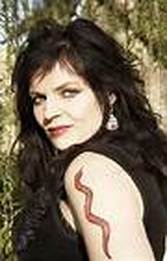 “Inanna…
“Inanna…Shedding your robe
Losing your crown
Bow to the serpentine sister who calls you down.
Share with the world
What you have found
When you were underground.”
Wendy Rule, World Between Worlds, 2000
When she arrives before her sister, Inanna/Ishtar is naked, and Ereshkigal, fearing her sister will attempt a coup, kills her.
Her death has terrible consequences, including the cessation of all earthly sexual intimacy and fertility. Ea, the god of wisdom, plots to revive Inanna/Ishtar and return her to the upper world. His plot succeeds, but there is an ancient Mesopotamian saying:
“No one comes back from the Underworld unmarked.”
Once a space has been created in the lower world, it cannot be left empty. Inanna/Ishtar is instructed to ascend with a band of demons to the upper world, and find her own replacement.
In the world above, she finds her husband Tammuz dressed regally and lounging on her throne, apparently unaffected by her death. Enraged, she instructs the demons to drag him below with them.
Later, Inanna/Ishtar regrets her brash act. She arranges for Tammuz’s sister to be a substitute for him during six months of the year—thus explaining the mystery of the sun’s diminishing in winter and growing stronger in summer.
Ishtar/Inanna was one of the most popular deities of the Mesopotamian pantheon, yet in modern day she has slipped into anonymity. She is seen in the modern era most often in her third, celestial, form as the planet Venus, the morning and evening star.
But if you look carefully, you can find her. In science fiction, for instance, as a beautiful yet self-destructive stripper in Neil Gaiman’s comic The Sandman: Brief Lives. Gaiman knows his Mesopotamian myths…the “stripping” of Ishtar could be a wink to the ancient narrative of Ianna’s Descent.
 Did you ever wonder where Wonder Woman came up with her unusual garb? She was influenced by Ishtar. Both figures are represented as a warrior who graces the battlefield wearing bracelets and a tiara, brandishing a shield and demonstrating a fierce commitment to justice.
Did you ever wonder where Wonder Woman came up with her unusual garb? She was influenced by Ishtar. Both figures are represented as a warrior who graces the battlefield wearing bracelets and a tiara, brandishing a shield and demonstrating a fierce commitment to justice.What better time than the present to remember Ishtar/Ianna? The modern female embraces all of her complex and confusing aspects: Sex and violence. Reproduction and death. Striving for beauty, but also experiencing terror. Centrality and marginality. Order and chaos.
What was true in megalithic times still rings true today.
As Pat Benatar says, Love is a Battlefield.
Author’s Note:
I borrowed heavily from several sources for this blog. Thank you to the following sources:
www.Ancient-origins.net.
Love is a Battlefield: The Legend of Ishtar, by Louis Pryke/The Conversation.
www.brooklynmuseum.org. Ishtar
Descent of Inanna
art by Julie Newdoll
and…
My dear friend, Wendy Rule.
Inanna, World Between Worlds
Published on April 22, 2018 18:36
April 13, 2018
Reno Redux
I’m home from the Reno West Coast Crime conference, and I will remember it fondly for many reasons. I got to be on my first authors’ panel (moderate it, in fact), and not only was it a success, it was also a LOT of fun.
I was disappointed that my panelist Eileen McGill got snowed in at her home in California and missed both the panel and the entire conference. Turns out, you have to drive through Donner’s Pass to get to Reno from her house and it began snowing just before she could get through. I was supposed to go on a Donner Party historical tour, but it was also cancelled due to the weather.
In addition to hosting the panel, I attended excellent workshops and met a bunch of interesting new authors.
I always like to read authors I’ve met personally, talked with or listened to on author panels. It makes their stories resonate more deeply, to know something about the author.
I became interested in Diana Gabaldon’s Outlander series after hearing her speak about how she decided to write that series. And her presentation on the decisions she and the filming crew made when the books were adapted for the Starz series pointed out the difficulty of cutting a six- hundred-page novel into 60 -minute episodes for the Starz mini-series.
At the first writers’ conference I ever attended, Lisa Gardner, the guest speaker, told us about sneaking out of the house and driving downtown to interview prostitutes for one of her first books, Say Goodbye. Now I’ve read more than a dozen of her novels.
At that same conference, a handsome ex-lawyer I’d never heard of, Bob Dugoni, congratulated me on winning first place in the conference’s unpublished writer contest that year. He was so nice, I picked up one of his books and read it on the plane ride home. It was really, really good. Now, everyone who reads suspense knows his name.
So, I attended Left Coast Crime this year, not just as an author, but also as a reader…a reader with an eye out to discover some new favorite authors. Some of them have just written their debut novel. Others are only new to me. I tried to make some type of personal connection with each writer on this list.
Please, take a look, and give some books I’ve listed a try, if you like suspense or crime fiction. Or, check out the whole gallery of titles for each author at your bookseller of choice.
Good reading!
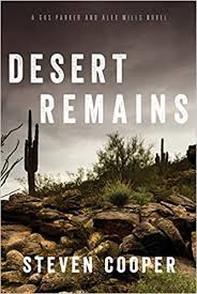 Steven Cooper – Desert Remains. A literature-loving homicide detective and a reluctant psychic stalk a psychopath who signs his gruesome crime tableaux with petroglyphs in the Arizona desert. An ingenious and promising series debut. Why I’m reading – Steven was so knowledgeable on a panel about law enforcement research. Cooper is a former TV reporter with multiple Emmys. The stuff he said about research made a lot of sense. Plus, his new novel is set in Phoenix, so I get to test those research skills.
Steven Cooper – Desert Remains. A literature-loving homicide detective and a reluctant psychic stalk a psychopath who signs his gruesome crime tableaux with petroglyphs in the Arizona desert. An ingenious and promising series debut. Why I’m reading – Steven was so knowledgeable on a panel about law enforcement research. Cooper is a former TV reporter with multiple Emmys. The stuff he said about research made a lot of sense. Plus, his new novel is set in Phoenix, so I get to test those research skills.
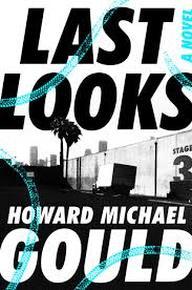 Howard Michael Gould – Last Looks - This book is touted as a new spin on a Hollywood P.I. mystery. With a blend of humor and suspense that calls to mind Harlan Coben and Robert Crais, Howard Michael Gould brings to life the quirky Charlie Waldo, a former cop confined to 100 worldly possessions and the claustrophobia of his own guilt over a former case gone bad. His journey back to the world is a ride well worth taking.
Why I’m reading
– My roommate Sharon Moore and I both met Howard the first night in the Lobby Bar and we found him delightful. You know how you feel when someone talks with you and listens, I mean, really listens? That’s Howard. His pedigreed background is Madison Avenue, where he won three Clios, and he was the executive producer and head writer on the TV show Cybill when it won the Golden Globe for best comedy series. I’m hoping his move to novels will be just as golden. It’s slated for publication in August.
Howard Michael Gould – Last Looks - This book is touted as a new spin on a Hollywood P.I. mystery. With a blend of humor and suspense that calls to mind Harlan Coben and Robert Crais, Howard Michael Gould brings to life the quirky Charlie Waldo, a former cop confined to 100 worldly possessions and the claustrophobia of his own guilt over a former case gone bad. His journey back to the world is a ride well worth taking.
Why I’m reading
– My roommate Sharon Moore and I both met Howard the first night in the Lobby Bar and we found him delightful. You know how you feel when someone talks with you and listens, I mean, really listens? That’s Howard. His pedigreed background is Madison Avenue, where he won three Clios, and he was the executive producer and head writer on the TV show Cybill when it won the Golden Globe for best comedy series. I’m hoping his move to novels will be just as golden. It’s slated for publication in August.
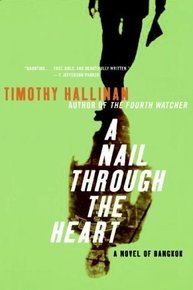 Timothy Halliman – A Nail Through the Heart - American travel writer Poke Rafferty is out to right some serious wrongs on the predatory streets of Bangkok. While attempting to adopt a homeless girl, rescue a potentially murderous urchin known as Superman, and build a lasting relationship with the former bar girl he loves, Poke is pulled into two brutal mysteries. One involves a notorious Khmer Rouge torturer, the other a series of child-porn photos.
Timothy Halliman – A Nail Through the Heart - American travel writer Poke Rafferty is out to right some serious wrongs on the predatory streets of Bangkok. While attempting to adopt a homeless girl, rescue a potentially murderous urchin known as Superman, and build a lasting relationship with the former bar girl he loves, Poke is pulled into two brutal mysteries. One involves a notorious Khmer Rouge torturer, the other a series of child-porn photos.
As he doggedly plumbs these ghastly depths, Rafferty matures from a play-it-as-it-lays layabout into a man willing to meet his lover's culture more than halfway and find his moral compass at a time when the victims can be as guilty as the murderers are innocent. The fact that the referenced pedophile photo series and Phnom Penh torture house both existed heightens the impact of a narrative that's already deeply felt. Hallinan is off to a surefooted start with this new series. Why I’m reading – Halliman is a veteran writer who happens to be new to me. I attended both of his panels and, when he described his characters in the Taking Emotional Risks panel, it was easy to see this man cares deeply about his characters. He writes 2 series. When I asked him, after the panel, which book to read first if I love character-driven suspense, he recommended this first book of his Bangkok series.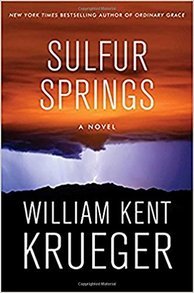 William Kent Krueger – Sulfur Springs - Krueger is the award-winning author of seventeen previous Cork O’Connor novels, the rest of them based in Minnesota.
William Kent Krueger – Sulfur Springs - Krueger is the award-winning author of seventeen previous Cork O’Connor novels, the rest of them based in Minnesota.
For this book, he moves his protagonist to the Arizona desert and tees up on the timely subject of illegal immigration. Whatever our political views, this is a subject that warrants thought and discussion, although Cork feels like a fish out of water.
Why I’m reading – Krueger won the Lefty award this year for best mystery, so I came home and read it immediately. His style is a bit too back-woods folksy for my taste, but the writing is excellent. If you like cozy mysteries, and a protagonist with strong moral principles, I’m betting you’ll like this book.
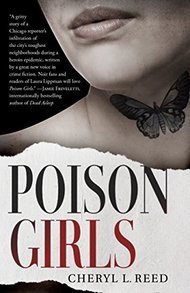 Cheryl Reed –Poison Girls - It’s the summer of 2008. Chicago’s Hyde Park Senator is running for the White House, the city is vying to host the 2016 Summer Olympics, and “Poison,” a lethal form of heroin, has killed more than 250 people, including dozens of suburban girls from prominent families.
Cheryl Reed –Poison Girls - It’s the summer of 2008. Chicago’s Hyde Park Senator is running for the White House, the city is vying to host the 2016 Summer Olympics, and “Poison,” a lethal form of heroin, has killed more than 250 people, including dozens of suburban girls from prominent families.
Natalie Delaney, a crime reporter from the Chicago Times, discovers that daughters of Democratic powerhouses are the real targets. Obsessed with finding who is behind the killings, Natalie becomes entangled in an underworld where drugs, cops, gangs, politics, and privilege collide. Risking everything, this reporter becomes the story… Why I’m reading- Cheryl is a former editor and reporter at the Chicago Sun Times, a professor at Syracuse University, and a journalism grad from U of Missouri, my alma mater. Her past is so full of excitement and awards, I’m willing to give her debut fiction novel a try—and it’s a plot that could have been ripped from today’s headlines.
 Mark Wheaton- Fields of Wrath - Following his ordination as a priest, Father Luis Chavez returns to the mean streets of his youth, hoping to put his past behind him. But the brutal murder of a worker in Ventura County’s vast farm fields compels Luis to return to his criminal roots in order to unravel a massive conspiracy. Teaming up with Michael Story, an ambitious Los Angeles deputy DA, Chavez goes undercover as a farm laborer to bring down an immense human-trafficking ring tied to one of California’s most prominent and powerful families.
Mark Wheaton- Fields of Wrath - Following his ordination as a priest, Father Luis Chavez returns to the mean streets of his youth, hoping to put his past behind him. But the brutal murder of a worker in Ventura County’s vast farm fields compels Luis to return to his criminal roots in order to unravel a massive conspiracy. Teaming up with Michael Story, an ambitious Los Angeles deputy DA, Chavez goes undercover as a farm laborer to bring down an immense human-trafficking ring tied to one of California’s most prominent and powerful families.
Fighting to stay on the path of the righteous while confronting evil at every turn, Father Chavez finds himself in a battle of good versus evil, with the souls of hundreds hanging in the balance. Why I’m reading – A Priest who infiltrates a human-trafficking ring caught my interest. Plus, I have human trafficking in my work-in-progress, so it will be interesting to compare.
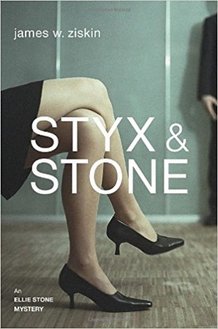 James (Jim) Ziskin - Stix and Stones - "If you were a man, you’d make a good detective.”
James (Jim) Ziskin - Stix and Stones - "If you were a man, you’d make a good detective.”
Ellie is sure that Sgt. McKeever meant that as a compliment, but that identity-a girl wanting to do a man's job-has throttled her for too long. It's 1960, and Ellie doesn't want to blaze any trails for women; she just wants to be a reporter, one who doesn't need to swat hands off her behind at every turn.
Adrift in her career, Ellie is back in New York City after receiving news that her estranged father, a renowned Dante scholar and distinguished professor, is near death after a savage bludgeoning in his home. The police suspect a routine burglary, but Ellie has her doubts. When a second attempt is made on her father's life, in the form of an "accident" in the hospital's ICU, Ellie's suspicions are confirmed.
Then another professor turns up dead, and Ellie's investigation turns to her father's university colleagues. She embarks on a thorny journey of discovery and reconciliation, as she pursues an investigation that offers her both a chance at redemption in her father's eyes, and the risk of losing him forever.
Why I’m reading – First, every book of Ziskin’s has an intriguing premise. Second, the man has won almost every suspense award out there, and his latest novel was nominated for Lefty’s Best Novel award. Third, he was friendly and open and not at all “lofty” at the conference, despite being one of the best-known authors at the conference. Based on his recommendation, I’m starting at the beginning of his series.
Good reading! Leave and note and let me know if you find anything you like.
I was disappointed that my panelist Eileen McGill got snowed in at her home in California and missed both the panel and the entire conference. Turns out, you have to drive through Donner’s Pass to get to Reno from her house and it began snowing just before she could get through. I was supposed to go on a Donner Party historical tour, but it was also cancelled due to the weather.
In addition to hosting the panel, I attended excellent workshops and met a bunch of interesting new authors.
I always like to read authors I’ve met personally, talked with or listened to on author panels. It makes their stories resonate more deeply, to know something about the author.
I became interested in Diana Gabaldon’s Outlander series after hearing her speak about how she decided to write that series. And her presentation on the decisions she and the filming crew made when the books were adapted for the Starz series pointed out the difficulty of cutting a six- hundred-page novel into 60 -minute episodes for the Starz mini-series.
At the first writers’ conference I ever attended, Lisa Gardner, the guest speaker, told us about sneaking out of the house and driving downtown to interview prostitutes for one of her first books, Say Goodbye. Now I’ve read more than a dozen of her novels.
At that same conference, a handsome ex-lawyer I’d never heard of, Bob Dugoni, congratulated me on winning first place in the conference’s unpublished writer contest that year. He was so nice, I picked up one of his books and read it on the plane ride home. It was really, really good. Now, everyone who reads suspense knows his name.
So, I attended Left Coast Crime this year, not just as an author, but also as a reader…a reader with an eye out to discover some new favorite authors. Some of them have just written their debut novel. Others are only new to me. I tried to make some type of personal connection with each writer on this list.
Please, take a look, and give some books I’ve listed a try, if you like suspense or crime fiction. Or, check out the whole gallery of titles for each author at your bookseller of choice.
Good reading!
 Steven Cooper – Desert Remains. A literature-loving homicide detective and a reluctant psychic stalk a psychopath who signs his gruesome crime tableaux with petroglyphs in the Arizona desert. An ingenious and promising series debut. Why I’m reading – Steven was so knowledgeable on a panel about law enforcement research. Cooper is a former TV reporter with multiple Emmys. The stuff he said about research made a lot of sense. Plus, his new novel is set in Phoenix, so I get to test those research skills.
Steven Cooper – Desert Remains. A literature-loving homicide detective and a reluctant psychic stalk a psychopath who signs his gruesome crime tableaux with petroglyphs in the Arizona desert. An ingenious and promising series debut. Why I’m reading – Steven was so knowledgeable on a panel about law enforcement research. Cooper is a former TV reporter with multiple Emmys. The stuff he said about research made a lot of sense. Plus, his new novel is set in Phoenix, so I get to test those research skills.
 Howard Michael Gould – Last Looks - This book is touted as a new spin on a Hollywood P.I. mystery. With a blend of humor and suspense that calls to mind Harlan Coben and Robert Crais, Howard Michael Gould brings to life the quirky Charlie Waldo, a former cop confined to 100 worldly possessions and the claustrophobia of his own guilt over a former case gone bad. His journey back to the world is a ride well worth taking.
Why I’m reading
– My roommate Sharon Moore and I both met Howard the first night in the Lobby Bar and we found him delightful. You know how you feel when someone talks with you and listens, I mean, really listens? That’s Howard. His pedigreed background is Madison Avenue, where he won three Clios, and he was the executive producer and head writer on the TV show Cybill when it won the Golden Globe for best comedy series. I’m hoping his move to novels will be just as golden. It’s slated for publication in August.
Howard Michael Gould – Last Looks - This book is touted as a new spin on a Hollywood P.I. mystery. With a blend of humor and suspense that calls to mind Harlan Coben and Robert Crais, Howard Michael Gould brings to life the quirky Charlie Waldo, a former cop confined to 100 worldly possessions and the claustrophobia of his own guilt over a former case gone bad. His journey back to the world is a ride well worth taking.
Why I’m reading
– My roommate Sharon Moore and I both met Howard the first night in the Lobby Bar and we found him delightful. You know how you feel when someone talks with you and listens, I mean, really listens? That’s Howard. His pedigreed background is Madison Avenue, where he won three Clios, and he was the executive producer and head writer on the TV show Cybill when it won the Golden Globe for best comedy series. I’m hoping his move to novels will be just as golden. It’s slated for publication in August.
 Timothy Halliman – A Nail Through the Heart - American travel writer Poke Rafferty is out to right some serious wrongs on the predatory streets of Bangkok. While attempting to adopt a homeless girl, rescue a potentially murderous urchin known as Superman, and build a lasting relationship with the former bar girl he loves, Poke is pulled into two brutal mysteries. One involves a notorious Khmer Rouge torturer, the other a series of child-porn photos.
Timothy Halliman – A Nail Through the Heart - American travel writer Poke Rafferty is out to right some serious wrongs on the predatory streets of Bangkok. While attempting to adopt a homeless girl, rescue a potentially murderous urchin known as Superman, and build a lasting relationship with the former bar girl he loves, Poke is pulled into two brutal mysteries. One involves a notorious Khmer Rouge torturer, the other a series of child-porn photos.As he doggedly plumbs these ghastly depths, Rafferty matures from a play-it-as-it-lays layabout into a man willing to meet his lover's culture more than halfway and find his moral compass at a time when the victims can be as guilty as the murderers are innocent. The fact that the referenced pedophile photo series and Phnom Penh torture house both existed heightens the impact of a narrative that's already deeply felt. Hallinan is off to a surefooted start with this new series. Why I’m reading – Halliman is a veteran writer who happens to be new to me. I attended both of his panels and, when he described his characters in the Taking Emotional Risks panel, it was easy to see this man cares deeply about his characters. He writes 2 series. When I asked him, after the panel, which book to read first if I love character-driven suspense, he recommended this first book of his Bangkok series.
 William Kent Krueger – Sulfur Springs - Krueger is the award-winning author of seventeen previous Cork O’Connor novels, the rest of them based in Minnesota.
William Kent Krueger – Sulfur Springs - Krueger is the award-winning author of seventeen previous Cork O’Connor novels, the rest of them based in Minnesota. For this book, he moves his protagonist to the Arizona desert and tees up on the timely subject of illegal immigration. Whatever our political views, this is a subject that warrants thought and discussion, although Cork feels like a fish out of water.
Why I’m reading – Krueger won the Lefty award this year for best mystery, so I came home and read it immediately. His style is a bit too back-woods folksy for my taste, but the writing is excellent. If you like cozy mysteries, and a protagonist with strong moral principles, I’m betting you’ll like this book.
 Cheryl Reed –Poison Girls - It’s the summer of 2008. Chicago’s Hyde Park Senator is running for the White House, the city is vying to host the 2016 Summer Olympics, and “Poison,” a lethal form of heroin, has killed more than 250 people, including dozens of suburban girls from prominent families.
Cheryl Reed –Poison Girls - It’s the summer of 2008. Chicago’s Hyde Park Senator is running for the White House, the city is vying to host the 2016 Summer Olympics, and “Poison,” a lethal form of heroin, has killed more than 250 people, including dozens of suburban girls from prominent families.Natalie Delaney, a crime reporter from the Chicago Times, discovers that daughters of Democratic powerhouses are the real targets. Obsessed with finding who is behind the killings, Natalie becomes entangled in an underworld where drugs, cops, gangs, politics, and privilege collide. Risking everything, this reporter becomes the story… Why I’m reading- Cheryl is a former editor and reporter at the Chicago Sun Times, a professor at Syracuse University, and a journalism grad from U of Missouri, my alma mater. Her past is so full of excitement and awards, I’m willing to give her debut fiction novel a try—and it’s a plot that could have been ripped from today’s headlines.
 Mark Wheaton- Fields of Wrath - Following his ordination as a priest, Father Luis Chavez returns to the mean streets of his youth, hoping to put his past behind him. But the brutal murder of a worker in Ventura County’s vast farm fields compels Luis to return to his criminal roots in order to unravel a massive conspiracy. Teaming up with Michael Story, an ambitious Los Angeles deputy DA, Chavez goes undercover as a farm laborer to bring down an immense human-trafficking ring tied to one of California’s most prominent and powerful families.
Mark Wheaton- Fields of Wrath - Following his ordination as a priest, Father Luis Chavez returns to the mean streets of his youth, hoping to put his past behind him. But the brutal murder of a worker in Ventura County’s vast farm fields compels Luis to return to his criminal roots in order to unravel a massive conspiracy. Teaming up with Michael Story, an ambitious Los Angeles deputy DA, Chavez goes undercover as a farm laborer to bring down an immense human-trafficking ring tied to one of California’s most prominent and powerful families.Fighting to stay on the path of the righteous while confronting evil at every turn, Father Chavez finds himself in a battle of good versus evil, with the souls of hundreds hanging in the balance. Why I’m reading – A Priest who infiltrates a human-trafficking ring caught my interest. Plus, I have human trafficking in my work-in-progress, so it will be interesting to compare.
 James (Jim) Ziskin - Stix and Stones - "If you were a man, you’d make a good detective.”
James (Jim) Ziskin - Stix and Stones - "If you were a man, you’d make a good detective.”Ellie is sure that Sgt. McKeever meant that as a compliment, but that identity-a girl wanting to do a man's job-has throttled her for too long. It's 1960, and Ellie doesn't want to blaze any trails for women; she just wants to be a reporter, one who doesn't need to swat hands off her behind at every turn.
Adrift in her career, Ellie is back in New York City after receiving news that her estranged father, a renowned Dante scholar and distinguished professor, is near death after a savage bludgeoning in his home. The police suspect a routine burglary, but Ellie has her doubts. When a second attempt is made on her father's life, in the form of an "accident" in the hospital's ICU, Ellie's suspicions are confirmed.
Then another professor turns up dead, and Ellie's investigation turns to her father's university colleagues. She embarks on a thorny journey of discovery and reconciliation, as she pursues an investigation that offers her both a chance at redemption in her father's eyes, and the risk of losing him forever.
Why I’m reading – First, every book of Ziskin’s has an intriguing premise. Second, the man has won almost every suspense award out there, and his latest novel was nominated for Lefty’s Best Novel award. Third, he was friendly and open and not at all “lofty” at the conference, despite being one of the best-known authors at the conference. Based on his recommendation, I’m starting at the beginning of his series.
Good reading! Leave and note and let me know if you find anything you like.
Published on April 13, 2018 18:49
April 6, 2018
The Battle to Defeat Lyme Disease
Here’s why I love being a writer. I get to take snippets of information and weave them together into a cohesive story, and then share it with you. Sometimes the story is a fiction novel. Sometimes, like today, it’s factual.  Before I get to this posting of researched facts, let me just say, the human brain is an amazing organ. As testimony, I’d like to give you the circuitous route mine took to get around to writing about Lyme disease. In the 1980s I worked in the advertising department at the headquarters of a national real estate company. There, at ERA Real Estate, I worked for one of my favorite bosses in my career. His name was Harvey. He was soft-spoken, had a wicked sense of humor, and honestly cared about the people he hired. So when I reported to work one Monday to find Harvey had been hospitalized over the weekend, I was concerned. He’d been camping with his wife and found a tick embedded in his arm when they got home.
Before I get to this posting of researched facts, let me just say, the human brain is an amazing organ. As testimony, I’d like to give you the circuitous route mine took to get around to writing about Lyme disease. In the 1980s I worked in the advertising department at the headquarters of a national real estate company. There, at ERA Real Estate, I worked for one of my favorite bosses in my career. His name was Harvey. He was soft-spoken, had a wicked sense of humor, and honestly cared about the people he hired. So when I reported to work one Monday to find Harvey had been hospitalized over the weekend, I was concerned. He’d been camping with his wife and found a tick embedded in his arm when they got home.
Twenty-four hours later, he was dead. The diagnosis: Lyme disease. It attacked his heart.
Fast forward to the present.
I’m catching up on my many unread magazines, Prevention magazine for today, and come across an excellent article on Lyme disease. I think of Harvey and read it with interest. Turns out, one of the premier researchers on Lyme and other pathogens like tuberculosis and E. coli, Paul Keim, works at TGen at their Northern Arizona University campus in Flagstaff. That’s right in my backyard, and also where my son lives and will be finishing college.
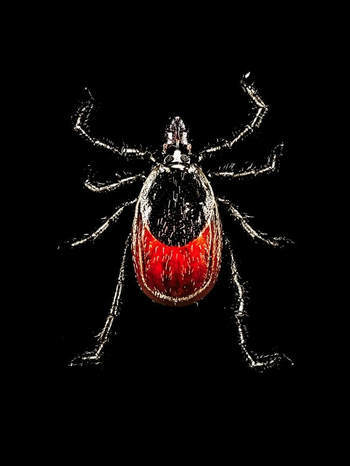 I’ll talk more about Keim’s research, but first, let’s talk about Lyme disease itself.
I’ll talk more about Keim’s research, but first, let’s talk about Lyme disease itself.
The bacterium that causes Lyme disease occurs naturally in mice squirrels and other small animals. The infection spreads as the black-legged tick –about the size of a speck of dirt before engorged with blood—feed on animals and then bite humans.
Lyme disease is the most commonly reported tick-borne illness in the United States, and the incidence is growing in number and geographic area. More than 38,000 cases are reported a year, but the unreported count is probably closer to 300,000. Fourteen states in the East and Upper Midwest report the majority of cases: Connecticut, Delaware, Maine, Maryland, Massachusetts, Minnesota, New Jersey, New York, New Hampshire, Pennsylvania, Rhode Island, Virginia, Vermont, and Wisconsin.
Fourteen states in the East and Upper Midwest report the majority of cases: Connecticut, Delaware, Maine, Maryland, Massachusetts, Minnesota, New Jersey, New York, New Hampshire, Pennsylvania, Rhode Island, Virginia, Vermont, and Wisconsin.
A bright red bull’s eye rash around the bite warrants an immediate trip to your doctor—and take the offending tick with you. If diagnosed and treated quickly with antibiotics, most people recover fully and quickly from Lyme, according to the CDC.
 But only somewhere between 40-70% of the people infected notice and/or receive treatment for the rash, and treating the disease after the initial symptoms is much, much trickier.
But only somewhere between 40-70% of the people infected notice and/or receive treatment for the rash, and treating the disease after the initial symptoms is much, much trickier.
Symptoms can masquerade as those of the flu, mononucleosis, inflamed and achy joints, migraines, or be hardly noticeable at all. Receiving antibiotics at this point—even for months at a time—may not help.
Treating an Elusive Bacteria
In the meantime, one post on my Facebook page about my research revealed that I know A LOT of people who have suffered from Lyme disease, some of them for decades.
“The harder you hit it with antibiotics, the stealthier it becomes,” says Julie Grano, who contracted Lyme 15 years ago. Her doctor referred Julie to the Infectious Disease Center (IDC) when the disease invaded her brain. She had been on intravenous antibiotics for two months. She reported that she actually felt better when she would finish a course of antibiotics, only to feel awful again and be put back on meds.
Her IDC doctor explained how, while the disease was under attack from antibiotics and losing, it would form sacs around itself and retreat to wait out the drug treatment, only to emerge and strengthen when the treatment was over.
“They did a CAT scan of my brain while I was suffering one of my migraines,” she says, “and they could actually see the sacs attached to my brain.”
Recent studies of confirmed Lyme patients report that, since many people are not treated early for Lyme, between 28 to 50% of them continue to suffer from fatigue, muscle and joint pain, and “brain fog” after completing standard treatment. The reason? As Julie Grano knows, Borrelia is no ordinary bacterium. In the same way a tick burrow into the skin, the corkscrew-shaped Borrelia worms its way into tissues that have few circulating antibodies, where it’s harder for antibiotics to reach. In addition, it has the ability to hijack the immune system while simultaneously wreaking havoc on every major organ system.
The reason? As Julie Grano knows, Borrelia is no ordinary bacterium. In the same way a tick burrow into the skin, the corkscrew-shaped Borrelia worms its way into tissues that have few circulating antibodies, where it’s harder for antibiotics to reach. In addition, it has the ability to hijack the immune system while simultaneously wreaking havoc on every major organ system.
“I got bit in New York,” says Kathleen Groger, a 22-year Lyme sufferer. “I ended up researching Lyme myself after I fell apart from all my strange, unexplained symptoms. Then I got a doctor trained in Lyme and was on antibiotics and other drugs for a year and a half.” It wasn’t until her mother sent her a picture of her dog, and a portion of her leg, with a bulls-eye rash on it, that she remembered the tick bite. While she cannot definitively link her symptoms to Lyme disease, she still has unexplained neuropathy and joint inflammation.
Better Diagnosis
While a vaccination is available to prevent Lyme disease in dogs, there is no prevention on the near horizon for people.
Scientists recognize that since antibiotics are currently the only approved therapy for Lyme disease, and antibiotics are only effective during the early stages of the disease, successful treatment hinges on developing a replacement for the inaccurate diagnostic tests doctors currently rely on.
Right now genetic sequencing is the most promising possibility.
 A Lyme activist named Tammy Crawford, who founded the patient advocacy organization Focus on Lyme after her daughter’s infection, was responsible for convincing researchers that the technology could be useful in diagnosing Lyme.
A Lyme activist named Tammy Crawford, who founded the patient advocacy organization Focus on Lyme after her daughter’s infection, was responsible for convincing researchers that the technology could be useful in diagnosing Lyme.
She reached out to Paul Keim at Translational Genomics Research Institute (TGen) in Flagstaff.
Keim, Regent’s Professor of Biology at Northern Arizona University, is kind of a rock star in the infectious disease research and bioterrorism world. Following the 2001 anthrax attacks on the East Coast, Keim and his research played a crucial role in aiding the United States military and intelligence community in their investigations. He conducted genomic analysis on the anthrax inside the contaminated letters that were sent, and tracked it back to a single flax of anthrax spores from a lab in Maryland.
 Keim has applied similar genetic tracking techniques to other cases. In Haiti, months after a devastating 2010 earthquake, a cholera outbreak killed 6,000 people. Keim and his team conducted DNA analysis of the cholera strain found in Haiti, and tracked it Nepalese U.N. peacekeepers in Haiti to assist with earthquake relief efforts.
Keim has applied similar genetic tracking techniques to other cases. In Haiti, months after a devastating 2010 earthquake, a cholera outbreak killed 6,000 people. Keim and his team conducted DNA analysis of the cholera strain found in Haiti, and tracked it Nepalese U.N. peacekeepers in Haiti to assist with earthquake relief efforts.
And when heroin users in Scotland contracted anthrax infections, Keim again traced the source of the anthrax contamination—this time to drug smuggling routes in the Middle East. Keim concluded that the anthrax-tainted heroin may have been cut with bonemeal that contained anthrax spores, or wrapped in contaminated animal hides during the drug’s journey to Scotland.
In his other hat, as Director of the Pathogen Genomics Division for TGen North, Keim and his team have been working on developing a test for Lyme disease. The results are promising. The test works by targeting and amplifying specific regions of the Lyme bacteria’s DNA, as well as genes from other types of tick-borne microbes. Scientists sequence the amplified DNA and determine which bacterial species are present by searching from that specific DNA. The test will be able to detect multiple strains of Lyme bacteria, plus all major co-infections and non-Lyme causes of disease like influenza and staph.
“Unlike current Lyme diagnostics, which depend on the immune system to develop antibodies against the bacteria, the new test will be able to detect even small remnants of Borrelia in the blood, and maybe in tissue too,” says Crawford.
If continued funding and clinical trials are successful, the test could be available within the year.
I’ve contacted Dr. Keim and TGen to get any updates on their testing results, and will keep you posted on their reply.
 Before I get to this posting of researched facts, let me just say, the human brain is an amazing organ. As testimony, I’d like to give you the circuitous route mine took to get around to writing about Lyme disease. In the 1980s I worked in the advertising department at the headquarters of a national real estate company. There, at ERA Real Estate, I worked for one of my favorite bosses in my career. His name was Harvey. He was soft-spoken, had a wicked sense of humor, and honestly cared about the people he hired. So when I reported to work one Monday to find Harvey had been hospitalized over the weekend, I was concerned. He’d been camping with his wife and found a tick embedded in his arm when they got home.
Before I get to this posting of researched facts, let me just say, the human brain is an amazing organ. As testimony, I’d like to give you the circuitous route mine took to get around to writing about Lyme disease. In the 1980s I worked in the advertising department at the headquarters of a national real estate company. There, at ERA Real Estate, I worked for one of my favorite bosses in my career. His name was Harvey. He was soft-spoken, had a wicked sense of humor, and honestly cared about the people he hired. So when I reported to work one Monday to find Harvey had been hospitalized over the weekend, I was concerned. He’d been camping with his wife and found a tick embedded in his arm when they got home.Twenty-four hours later, he was dead. The diagnosis: Lyme disease. It attacked his heart.
Fast forward to the present.
I’m catching up on my many unread magazines, Prevention magazine for today, and come across an excellent article on Lyme disease. I think of Harvey and read it with interest. Turns out, one of the premier researchers on Lyme and other pathogens like tuberculosis and E. coli, Paul Keim, works at TGen at their Northern Arizona University campus in Flagstaff. That’s right in my backyard, and also where my son lives and will be finishing college.
 I’ll talk more about Keim’s research, but first, let’s talk about Lyme disease itself.
I’ll talk more about Keim’s research, but first, let’s talk about Lyme disease itself.The bacterium that causes Lyme disease occurs naturally in mice squirrels and other small animals. The infection spreads as the black-legged tick –about the size of a speck of dirt before engorged with blood—feed on animals and then bite humans.
Lyme disease is the most commonly reported tick-borne illness in the United States, and the incidence is growing in number and geographic area. More than 38,000 cases are reported a year, but the unreported count is probably closer to 300,000.
 Fourteen states in the East and Upper Midwest report the majority of cases: Connecticut, Delaware, Maine, Maryland, Massachusetts, Minnesota, New Jersey, New York, New Hampshire, Pennsylvania, Rhode Island, Virginia, Vermont, and Wisconsin.
Fourteen states in the East and Upper Midwest report the majority of cases: Connecticut, Delaware, Maine, Maryland, Massachusetts, Minnesota, New Jersey, New York, New Hampshire, Pennsylvania, Rhode Island, Virginia, Vermont, and Wisconsin.A bright red bull’s eye rash around the bite warrants an immediate trip to your doctor—and take the offending tick with you. If diagnosed and treated quickly with antibiotics, most people recover fully and quickly from Lyme, according to the CDC.
 But only somewhere between 40-70% of the people infected notice and/or receive treatment for the rash, and treating the disease after the initial symptoms is much, much trickier.
But only somewhere between 40-70% of the people infected notice and/or receive treatment for the rash, and treating the disease after the initial symptoms is much, much trickier.Symptoms can masquerade as those of the flu, mononucleosis, inflamed and achy joints, migraines, or be hardly noticeable at all. Receiving antibiotics at this point—even for months at a time—may not help.
Treating an Elusive Bacteria
In the meantime, one post on my Facebook page about my research revealed that I know A LOT of people who have suffered from Lyme disease, some of them for decades.
“The harder you hit it with antibiotics, the stealthier it becomes,” says Julie Grano, who contracted Lyme 15 years ago. Her doctor referred Julie to the Infectious Disease Center (IDC) when the disease invaded her brain. She had been on intravenous antibiotics for two months. She reported that she actually felt better when she would finish a course of antibiotics, only to feel awful again and be put back on meds.
Her IDC doctor explained how, while the disease was under attack from antibiotics and losing, it would form sacs around itself and retreat to wait out the drug treatment, only to emerge and strengthen when the treatment was over.
“They did a CAT scan of my brain while I was suffering one of my migraines,” she says, “and they could actually see the sacs attached to my brain.”
Recent studies of confirmed Lyme patients report that, since many people are not treated early for Lyme, between 28 to 50% of them continue to suffer from fatigue, muscle and joint pain, and “brain fog” after completing standard treatment.
 The reason? As Julie Grano knows, Borrelia is no ordinary bacterium. In the same way a tick burrow into the skin, the corkscrew-shaped Borrelia worms its way into tissues that have few circulating antibodies, where it’s harder for antibiotics to reach. In addition, it has the ability to hijack the immune system while simultaneously wreaking havoc on every major organ system.
The reason? As Julie Grano knows, Borrelia is no ordinary bacterium. In the same way a tick burrow into the skin, the corkscrew-shaped Borrelia worms its way into tissues that have few circulating antibodies, where it’s harder for antibiotics to reach. In addition, it has the ability to hijack the immune system while simultaneously wreaking havoc on every major organ system.“I got bit in New York,” says Kathleen Groger, a 22-year Lyme sufferer. “I ended up researching Lyme myself after I fell apart from all my strange, unexplained symptoms. Then I got a doctor trained in Lyme and was on antibiotics and other drugs for a year and a half.” It wasn’t until her mother sent her a picture of her dog, and a portion of her leg, with a bulls-eye rash on it, that she remembered the tick bite. While she cannot definitively link her symptoms to Lyme disease, she still has unexplained neuropathy and joint inflammation.
Better Diagnosis
While a vaccination is available to prevent Lyme disease in dogs, there is no prevention on the near horizon for people.
Scientists recognize that since antibiotics are currently the only approved therapy for Lyme disease, and antibiotics are only effective during the early stages of the disease, successful treatment hinges on developing a replacement for the inaccurate diagnostic tests doctors currently rely on.
Right now genetic sequencing is the most promising possibility.
 A Lyme activist named Tammy Crawford, who founded the patient advocacy organization Focus on Lyme after her daughter’s infection, was responsible for convincing researchers that the technology could be useful in diagnosing Lyme.
A Lyme activist named Tammy Crawford, who founded the patient advocacy organization Focus on Lyme after her daughter’s infection, was responsible for convincing researchers that the technology could be useful in diagnosing Lyme.She reached out to Paul Keim at Translational Genomics Research Institute (TGen) in Flagstaff.
Keim, Regent’s Professor of Biology at Northern Arizona University, is kind of a rock star in the infectious disease research and bioterrorism world. Following the 2001 anthrax attacks on the East Coast, Keim and his research played a crucial role in aiding the United States military and intelligence community in their investigations. He conducted genomic analysis on the anthrax inside the contaminated letters that were sent, and tracked it back to a single flax of anthrax spores from a lab in Maryland.
 Keim has applied similar genetic tracking techniques to other cases. In Haiti, months after a devastating 2010 earthquake, a cholera outbreak killed 6,000 people. Keim and his team conducted DNA analysis of the cholera strain found in Haiti, and tracked it Nepalese U.N. peacekeepers in Haiti to assist with earthquake relief efforts.
Keim has applied similar genetic tracking techniques to other cases. In Haiti, months after a devastating 2010 earthquake, a cholera outbreak killed 6,000 people. Keim and his team conducted DNA analysis of the cholera strain found in Haiti, and tracked it Nepalese U.N. peacekeepers in Haiti to assist with earthquake relief efforts.And when heroin users in Scotland contracted anthrax infections, Keim again traced the source of the anthrax contamination—this time to drug smuggling routes in the Middle East. Keim concluded that the anthrax-tainted heroin may have been cut with bonemeal that contained anthrax spores, or wrapped in contaminated animal hides during the drug’s journey to Scotland.
In his other hat, as Director of the Pathogen Genomics Division for TGen North, Keim and his team have been working on developing a test for Lyme disease. The results are promising. The test works by targeting and amplifying specific regions of the Lyme bacteria’s DNA, as well as genes from other types of tick-borne microbes. Scientists sequence the amplified DNA and determine which bacterial species are present by searching from that specific DNA. The test will be able to detect multiple strains of Lyme bacteria, plus all major co-infections and non-Lyme causes of disease like influenza and staph.
“Unlike current Lyme diagnostics, which depend on the immune system to develop antibodies against the bacteria, the new test will be able to detect even small remnants of Borrelia in the blood, and maybe in tissue too,” says Crawford.
If continued funding and clinical trials are successful, the test could be available within the year.
I’ve contacted Dr. Keim and TGen to get any updates on their testing results, and will keep you posted on their reply.
Published on April 06, 2018 20:18



